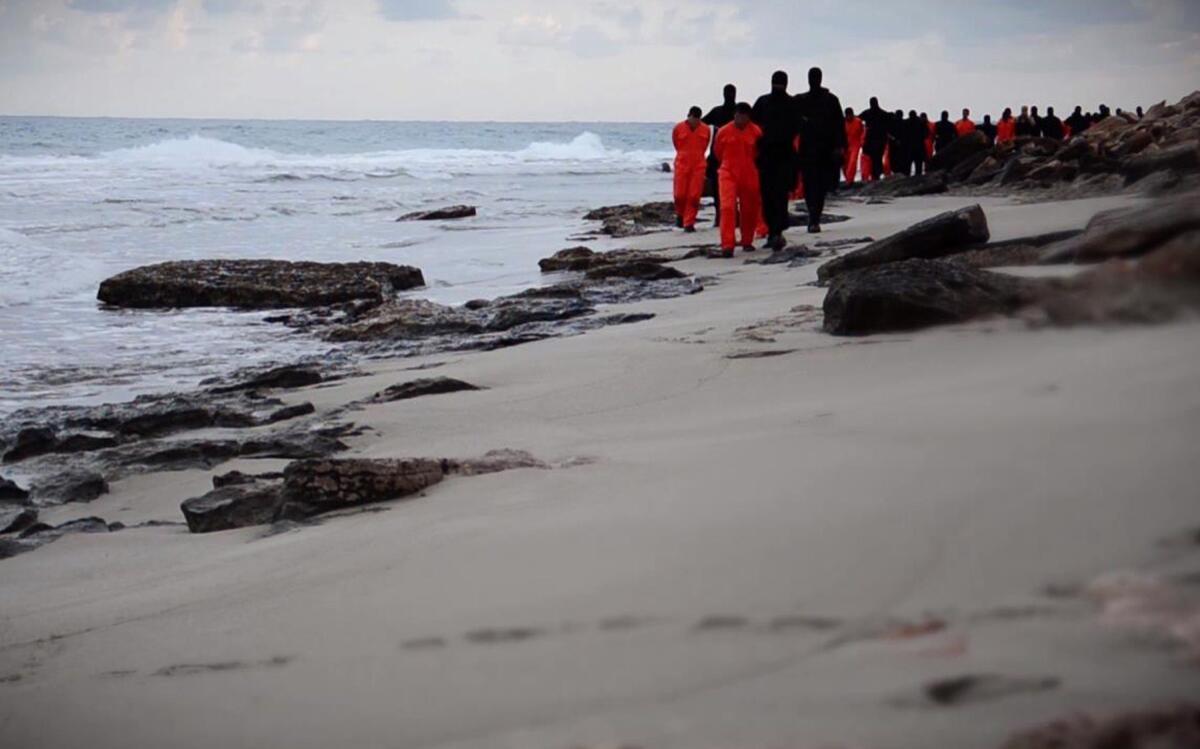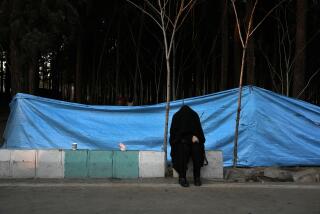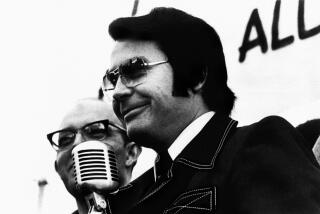Islamic State and its increasingly sophisticated cinema of terror

The cinematography is as crisp and chilling as a horror movie. Men in orange jumpsuits kneel on a beach beneath a sky of broken clouds. Executioners hover over them, dressed in black, knives aglint. A masked militant reads the death sentence. The camera pans across praying faces. Knives are raised, and 21 men are beheaded, blood spilling into the sand and mixing with the waves.
This and other recent execution videos released by Islamic State are slickly produced narratives of multiple camera angles, eerie tension and polished editing that suggest the filmmakers are versed in Hollywood aesthetics. Brutal and perverse, the clips, some infused with music and subtitles, carry a primeval message stylized for a world wired to social media and hypnotized by an endless pulse of competing images.
The beheadings and other killings, including the burning alive of a captured Jordanian fighter pilot, represent an increasingly sophisticated cinema of terror. They are intended to frighten and repulse Islamic State’s enemies. But the broader aim of the group, also known as ISIS, is to inspire alienated Muslims to enlist in a global battle against Christians, Jews, apostates and infidels. One militant described the mission as “breaking the cross, killing the swine.”
“ISIS knows its audience,” said Bruce Hoffman, an expert on terrorism and a fellow at the Woodrow Wilson International Center for Scholars in Washington. The militant network, he added, is attempting to entice young men from as many as 80 countries “who grew up in a culture of violent movies and video games and are jazzed by it. ... They are targeting those who see in violence a form of catharsis and a way to strike back at the enemy.”
The videos have been referred to as “jihadi snuff films.” In one Internet chat room, a writer compared the grisly scenes to the horror movies “Saw” and “Hostel.” The clips embody the fears and fascinations of our times, cutting across cultures with synchronized slaughter that arouses feelings of powerlessness and rage while exposing the difficulties the U.S. and other countries face in countering such arresting images.
The State Department’s Center for Strategic Counterterrorism Communications has not kept pace with the militants’ digital fluidity and an estimated tens of thousands of daily Twitter and other social media postings. The White House announced recently that it will expand a media campaign against extremism by working with technology companies and religious leaders. It will also collaborate with the United Arab Emirates on what it calls a “digital communications hub” to discredit extremist messages.
A U.S.-produced video appeared last year on YouTube that parodied the Islamic State’s recruitment tactics, saying new members would be taught “useful new skills,” such as “blowing up mosques” and “crucifying and executing Muslims.” The clip — part of a series called “Think Again Turn Away” — shows mangled corpses with the warning: “Travel is inexpensive because you won’t need a return ticket!”
Taking their time
The Islamic State’s production values have steadily improved since the network grew in Iraq and Syria; it now operates or has affiliates across North Africa and the Middle East. The group’s ranks have been bolstered by as many as several thousand recruits from Europe, which may be where the organization’s videographers learned their trade. The videos, including those showing the deaths of American, British and Japanese hostages, have been frequently released since last summer.
The most recent films unfold with almost surreal matter-of-factness, taking their time before death is carried out. Cameras pan and glance from different angles; anxiety builds. The executioners are masked and often dressed in black, including the militant who beheaded American hostage James Foley in August. In those videos and in the one in which 21 Coptic Christians were decapitated on the Libyan coast, the killers speak in English and relish in lurid exhibitionism.
The 22-minute video depicting the death of Jordanian pilot Lt. Moaz Kasasbeh, who was captured when his F-16 was shot down over Syria during a U.S.-led coalition bombing mission against Islamic State, was filmed amid war ruins. Militants dressed in fatigues and bracing Kalashnikovs stand guard. They seem as if regal sentinels in a perverted ideology to impose a primitive brand of Islamic law on what they see as a permissive and godless world.
Kasasbeh wanders bewildered down a hazy street that leads to a cage. The scene is interspersed with images showing the bodies of Syrians the Islamic State claims were killed by coalition missiles. Kasasbeh’s orange jumpsuit, reminiscent of those worn by suspected extremists held by the U.S. at Guantanamo Bay, appears soaked with accelerant. A short distance away, a militant holds up a torch and then touches it to the ground as fire — the camera lingers on wisps of white smoke — races toward the cage and Kasasbeh is engulfed.
“It’s horrific, but they know the power of storytelling and the importance of images,” said Robert Greenwald, president and founder of the Culver City-based Brave New Films, which has produced documentaries on the Iraq and Afghanistan wars. He added that the videos’ music, sound effects, camera angles and even costumes evoke suspense. “It really gives me pause to think about and to be concerned. It’s a level of sophistication that’s quite striking.”
‘The cinematic caliphate’
The choreographed terror honed by Islamic State and its affiliates have shaken a Middle East in turmoil from the 2011 uprisings and the enduring conflict between moderates and Islamist extremists. A headline this month in Al Bawaba, a news website headquartered in Amman, Jordan, read: “Horror production — Slick (ISIS) video hits cinematic low.” An article in the Beirut-based Al Akhbar newspaper described Islamic State as “the cinematic caliphate.”
“We are witnessing a completely different era, marked by a jihadist movement far more advanced than anything we have seen before,” the newspaper said. “They coincide with a far more sophisticated viewership, who have access to the source of information and can scrutinize any image. Today’s viewers … live in an age of instability where conspiracy theories prevails.... There is a direct relation between the new public psychology and ISIS’ new style of audiovisual production.”
The shocking nature of the Islamic State brand has sharpened the war of images in the Middle East. Imitating the video of Kasasbeh’s death, activists in Syria crammed children — dressed in orange coats and jumpsuits — into a cage as part of an artistic protest against not the brutality of the Islamic State but the relentless assaults on civilians by the government of President Bashar Assad. Such nonviolent pictures and videos of activists, however, have yet to spark the same sense of alarm conjured by Islamic State’s barbaric theater.
“They want to make sure we get the message,” Hoffman said of the impact of the videos. “The world’s most powerful media will amplify it and jump on it. ISIS is very sophisticated. They know they’re pushing our buttons.”
What images to broadcast has become a dilemma for news organizations. Some television news programs show segments of the videos; others, such as the “PBS NewsHour,” do not. “We show none with hostages, none with burnings or beheadings. We do no screen grabs of those images,” said Mike Melia, senior broadcast producer at “NewsHour.” “It’s a delicate balance. We want to show our viewers the news of what’s happening, but these [videos] are propaganda. We don’t want to be a vehicle for the Islamic State.”
The group’s images have their roots in the 1990s when Chechnyan rebels beheaded captured Russia soldiers with bayonets in their war against Moscow. The videos were crude but spread across the Internet, spurring a wincing voyeurism. Al Qaeda in Iraq improved production techniques in its videos of suicide bombings and executions after the 2003 U.S.-led invasion against Saddam Hussein. One faction of the group was so intent on shaping its message that it built a television studio at an outpost amid grazing sheep in the mountains of northern Iraq.
The Islamic radical message, especially on social media, was further honed by Anwar Awlaki, an American-born Yemeni imam whose command of English and understanding of Western sensibilities widened extremist recruiting circles. Awlaki released videos of his sermons and was behind the online magazine “Inspire,” which was filled with jihadist screeds and features with headlines such as “Make a Bomb in the Kitchen of Your Mom.” He was killed in 2011 by a U.S. drone strike in Yemen.
Islamic State, which follows a fundamentalist, apocalyptic version of Islam, has split from Al Qaeda over disputes regarding strategy, leadership, religious interpretation and Islamic State’s brutality against fellow Muslims.
The group’s leader, Abu Bakr Baghdadi, has accelerated the extremist message and roused passions on all sides. A day after the video of the beheadings of 21 Egyptian Christian laborers was released in February, the Egyptian government launched airstrikes on militant strongholds in Libya. The scenes of the executions, too powerful and graphic to be ignored, welled in the Egyptian consciousness, forcing President Abdel Fattah Sisi to act.
The video, which appears on extremist websites, begins serenely. The condemned walk with their executioners along the coast, as if on a stroll. A camera pans from overhead. Waves lap the shore. The victims stop in a line and drop to their knees in unison, the hands of their killers on their shoulders. The camera widens and then tightens on the masked face of a militant in crisp fatigues. He raises a long knife.
“Today we are on the south of Rome, on the land of Islam, Libya, sending another message,” the executioner says in clear English. The people of the cross, he warns, will be broken and the sea will mix with the blood of Christians. The kneeling men pray. They are pushed into the sand and murdered.
Twitter: @JeffreyLAT
More to Read
Only good movies
Get the Indie Focus newsletter, Mark Olsen's weekly guide to the world of cinema.
You may occasionally receive promotional content from the Los Angeles Times.







